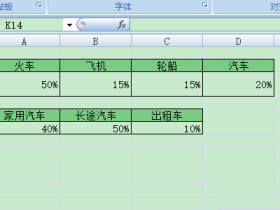- A+
所属分类:百科知识
散点密度图是在散点图的基础上,计算了每个散点周围分布了多少其他的点,并通过颜色表现出来。本文主要介绍了Python绘制散点密度图的三种方式,需要的可以参考下
方式一
1 2 3 4 5 6 7 8 9 10 11 12 13 14 15 16 17 18 19 20 21 22 23 24 25 | import matplotlib.pyplot as pltimport numpy as npfrom scipy.stats import gaussian_kdefrom mpl_toolkits.axes_grid1 import make_axes_locatablefrom matplotlib import rcParamsconfig = {"font.family":'Times New Roman',"font.size": 16,"mathtext.fontset":'stix'}rcParams.update(config)# 读取数据import pandas as pdfilename=r'F:/Rpython/lp37/testdata.xlsx'df2=pd.read_excel(filename)#读取文件x=df2['data1'].valuesy=df2['data2'].valuesxy = np.vstack([x,y])z = gaussian_kde(xy)(xy)idx = z.argsort()x, y, z = x[idx], y[idx], z[idx]fig,ax=plt.subplots(figsize=(12,9),dpi=100)scatter=ax.scatter(x,y,marker='o',c=z,edgecolors='',s=15,label='LST',cmap='Spectral_r')cbar=plt.colorbar(scatter,shrink=1,orientation='vertical',extend='both',pad=0.015,aspect=30,label='frequency') #orientation='horizontal'font3={'family':'SimHei','size':16,'color':'k'}plt.ylabel("估计值",fontdict=font3)plt.xlabel("预测值",fontdict=font3)plt.savefig('F:/Rpython/lp37/plot70.png',dpi=800,bbox_inches='tight',pad_inches=0)plt.show() |
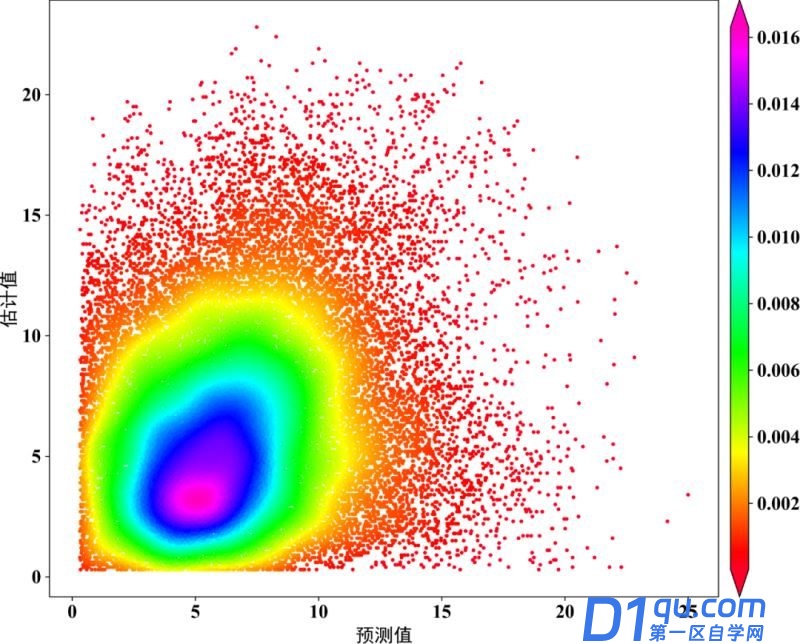
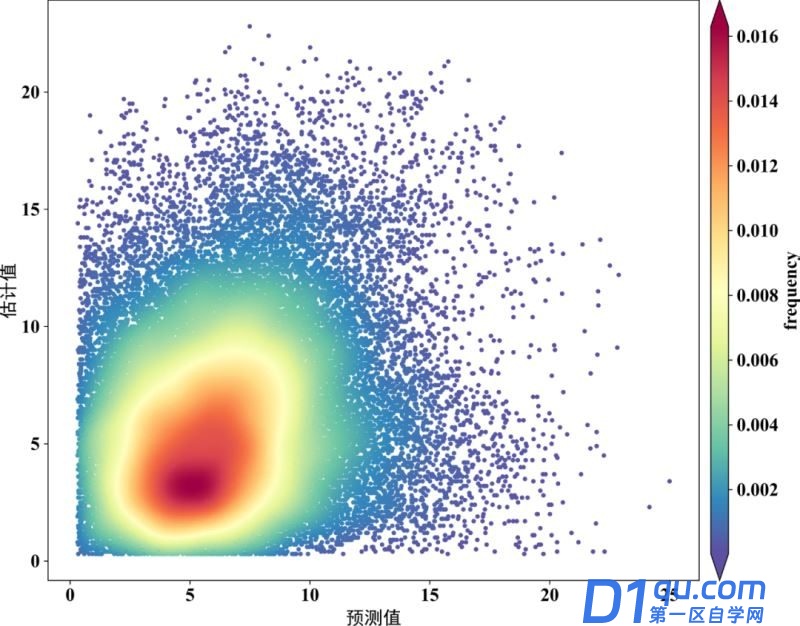
方式二
1 2 3 4 5 6 7 8 9 10 11 12 13 14 15 16 17 18 19 20 21 22 23 24 25 26 27 28 29 30 31 32 33 34 35 36 37 38 39 40 41 42 43 44 45 46 47 48 49 50 51 52 53 54 55 | from statistics import meanimport matplotlib.pyplot as pltfrom sklearn.metrics import explained_variance_score,r2_score,median_absolute_error,mean_squared_error,mean_absolute_errorfrom scipy import statsimport numpy as npfrom matplotlib import rcParamsconfig = {"font.family":'Times New Roman',"font.size": 16,"mathtext.fontset":'stix'}rcParams.update(config)def scatter_out_1(x,y): ## x,y为两个需要做对比分析的两个量。 # ==========计算评价指标========== BIAS = mean(x - y) MSE = mean_squared_error(x, y) RMSE = np.power(MSE, 0.5) R2 = r2_score(x, y) MAE = mean_absolute_error(x, y) EV = explained_variance_score(x, y) print('==========算法评价指标==========') print('BIAS:', '%.3f' % (BIAS)) print('Explained Variance(EV):', '%.3f' % (EV)) print('Mean Absolute Error(MAE):', '%.3f' % (MAE)) print('Mean squared error(MSE):', '%.3f' % (MSE)) print('Root Mean Squard Error(RMSE):', '%.3f' % (RMSE)) print('R_squared:', '%.3f' % (R2)) # ===========Calculate the point density========== xy = np.vstack([x, y]) z = stats.gaussian_kde(xy)(xy) # ===========Sort the points by density, so that the densest points are plotted last=========== idx = z.argsort() x, y, z = x[idx], y[idx], z[idx] def best_fit_slope_and_intercept(xs, ys): m = (((mean(xs) * mean(ys)) - mean(xs * ys)) / ((mean(xs) * mean(xs)) - mean(xs * xs))) b = mean(ys) - m * mean(xs) return m, b m, b = best_fit_slope_and_intercept(x, y) regression_line = [] for a in x: regression_line.append((m * a) + b) fig,ax=plt.subplots(figsize=(12,9),dpi=600) scatter=ax.scatter(x,y,marker='o',c=z*100,edgecolors='',s=15,label='LST',cmap='Spectral_r') cbar=plt.colorbar(scatter,shrink=1,orientation='vertical',extend='both',pad=0.015,aspect=30,label='frequency') plt.plot([0,25],[0,25],'black',lw=1.5) # 画的1:1线,线的颜色为black,线宽为0.8 plt.plot(x,regression_line,'red',lw=1.5) # 预测与实测数据之间的回归线 plt.axis([0,25,0,25]) # 设置线的范围 plt.xlabel('OBS',family = 'Times New Roman') plt.ylabel('PRE',family = 'Times New Roman') plt.xticks(fontproperties='Times New Roman') plt.yticks(fontproperties='Times New Roman') plt.text(1,24, '$N=%.f$' % len(y), family = 'Times New Roman') # text的位置需要根据x,y的大小范围进行调整。 plt.text(1,23, '$R^2=%.3f$' % R2, family = 'Times New Roman') plt.text(1,22, '$BIAS=%.4f$' % BIAS, family = 'Times New Roman') plt.text(1,21, '$RMSE=%.3f$' % RMSE, family = 'Times New Roman') plt.xlim(0,25) # 设置x坐标轴的显示范围 plt.ylim(0,25) # 设置y坐标轴的显示范围 plt.savefig('F:/Rpython/lp37/plot71.png',dpi=800,bbox_inches='tight',pad_inches=0) plt.show() |
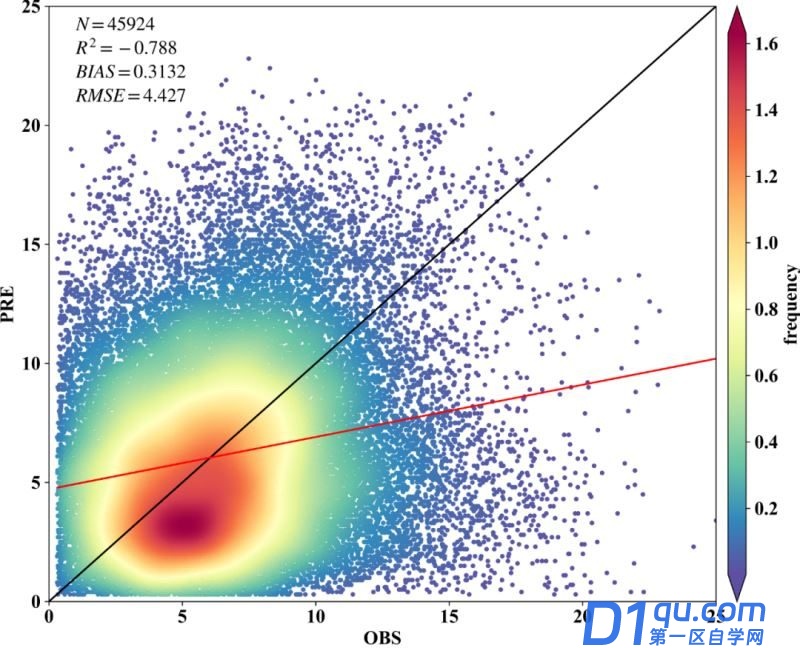
方式三
1 2 3 4 5 6 7 8 9 10 11 12 13 14 15 16 17 18 19 20 21 22 23 24 25 26 27 28 29 30 31 32 33 34 35 36 37 38 39 40 41 42 43 44 45 | import pandas as pdimport numpy as npfrom scipy import optimizeimport matplotlib.pyplot as pltfrom matplotlib import cmfrom matplotlib.colors import Normalizefrom scipy.stats import gaussian_kdefrom matplotlib import rcParamsconfig={"font.family":'Times New Roman',"font.size":16,"mathtext.fontset":'stix'}rcParams.update(config)# 读取数据filename=r'F:/Rpython/lp37/testdata.xlsx'df2=pd.read_excel(filename)#读取文件x=df2['data1'].values.ravel()y=df2['data2'].values.ravel()N = len(df2['data1'])#绘制拟合线x2 = np.linspace(-10,30)y2 = x2def f_1(x,A,B): return A*x + BA1,B1 = optimize.curve_fit(f_1,x,y)[0]y3 = A1*x + B1# Calculate the point densityxy = np.vstack([x,y])z = gaussian_kde(xy)(xy)norm = Normalize(vmin = np.min(z), vmax = np.max(z))#开始绘图fig,ax=plt.subplots(figsize=(12,9),dpi=600)scatter=ax.scatter(x,y,marker='o',c=z*100,edgecolors='',s=15,label='LST',cmap='Spectral_r')cbar=plt.colorbar(scatter,shrink=1,orientation='vertical',extend='both',pad=0.015,aspect=30,label='frequency')cbar.ax.locator_params(nbins=8)cbar.ax.set_yticklabels([0.005,0.010,0.015,0.020,0.025,0.030,0.035])#0,0.005,0.010,0.015,0.020,0.025,0.030,0.035ax.plot(x2,y2,color='k',linewidth=1.5,linestyle='--')ax.plot(x,y3,color='r',linewidth=2,linestyle='-')fontdict1 = {"size":16,"color":"k",'family':'Times New Roman'}ax.set_xlabel("PRE",fontdict=fontdict1)ax.set_ylabel("OBS",fontdict=fontdict1)# ax.grid(True)ax.set_xlim((0,25))ax.set_ylim((0,25))ax.set_xticks(np.arange(0,25.1,step=5))ax.set_yticks(np.arange(0,25.1,step=5))plt.savefig('F:/Rpython/lp37/plot72.png',dpi=800,bbox_inches='tight',pad_inches=0)plt.show() |
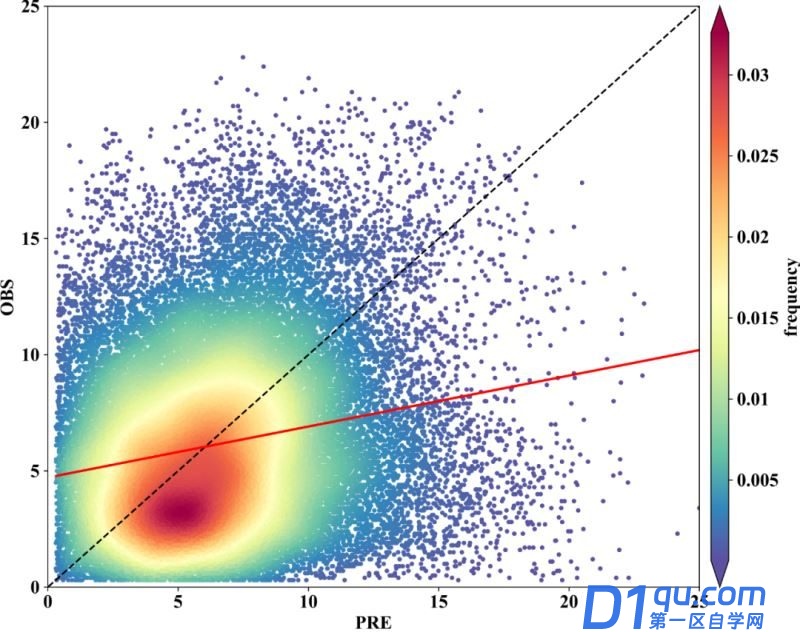
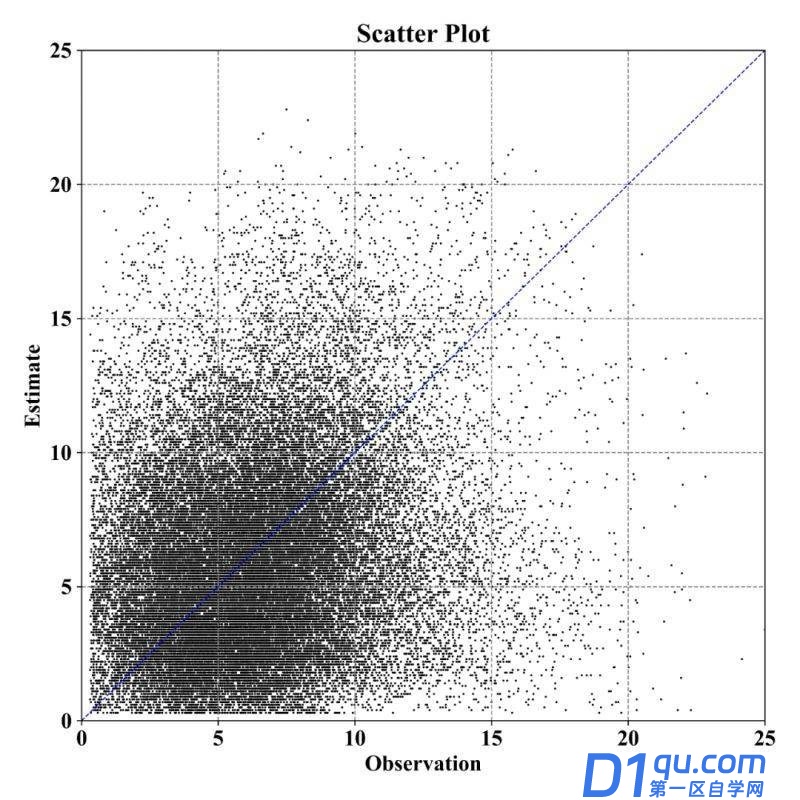
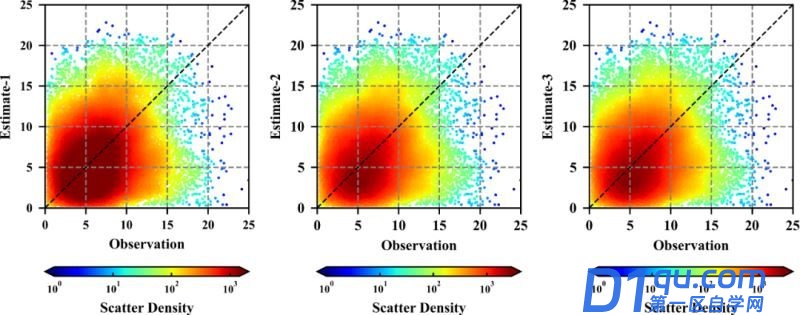
到此这篇关于Python绘制散点密度图的三种方式详解的文章就介绍到这了




